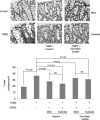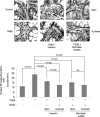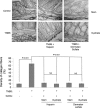Unfractionated heparin and new heparin analogues from ascidians (chordate-tunicate) ameliorate colitis in rats
- PMID: 19258310
- PMCID: PMC2670131
- DOI: 10.1074/jbc.M807211200
Unfractionated heparin and new heparin analogues from ascidians (chordate-tunicate) ameliorate colitis in rats
Abstract
The anti-inflammatory effect of mammalian heparin analogues, named dermatan sulfate and heparin, isolated from the ascidian Styela plicata was accessed in a TNBS-induced colitis model in rats. Subcutaneous administration of the invertebrate compounds during a 7-day period drastically reduced inflammation as observed by the normalization of the macroscopic and histological characteristics of the colon. At the molecular level, a decrease in the production of TNF-alpha, TGF-beta, and VEGF was observed, as well as a reduction of NF-kappaB and MAPK kinase activation. At the cellular level, the heparin analogues attenuated lymphocyte and macrophage recruitment and epithelial cell apoptosis. A drastic reduction in collagen-mediated fibrosis was also observed. No hemorrhagic events were observed after glycan treatment. These results strongly indicate the potential therapeutic use of these compounds for the treatment of colonic inflammation with a lower risk of hemorrhage when compared with mammalian heparin.
Figures










References
Publication types
MeSH terms
Substances
LinkOut - more resources
Full Text Sources
Medical

